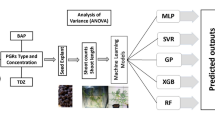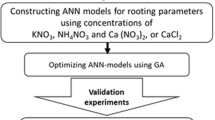Abstract
Mineral nutrition is a very important factor in the success of in vitro plant cultures. The aim was to compare the predictive capacity of the models obtained using a parametric technique such as multiple regression analysis with a nonparametric one such as artificial neural networks. These techniques were used for modeling the effect of total nitrogen concentration and the ratio nitrate: ammonium in the regeneration rate, oxidation rate, callus proliferation rate, number of buds per explant and buds-forming capacity index. Both the concentration of total nitrogen and the relationship between the concentrations of nitrate and ammonium influenced the morphogenetic responses. Optimal buds regeneration was in the range of 10–20 mM of the total nitrogen concentration and 1–2 of the nitrate: ammonium ratio. Higher concentrations of nitrogen produced an increase in the oxidation rate while the low nitrate: ammonium ratio favored the callus proliferation rate. Artificial neural network models presented a better precision to predict the different responses to the total content of nitrogen and the nitrate: ammonium rate, with higher coefficients of determination and correlation. They also presented a lower root mean square error for all the variables studied than the multiple regression analysis.
Key message
The use of artificial neural networks allows obtaining a better model of the effect of nitrogen on the organogenesis of Pinus taeda L. than traditional statistical techniques.












Similar content being viewed by others
Abbreviations
- ANNs:
-
Artificial neural networks
- BFC:
-
Bud-forming capacity
- MRA:
-
Multiple regression analysis
- NO3/NH4:
-
Nitrate: ammonium rate
- r:
-
Pearson’s correlation coefficient
- R2 :
-
Coefficient of determination
- RMSE:
-
Root mean squared error
- TNC:
-
Total nitrogen concentration
References
Akin M, Eyduran E, Reed BM (2017) Use of RSM and CHAID data mining algorithm for predicting mineral nutrition of hazelnut. Plant Cell Tissue Organ Cult 128(2):303–316
Alanagh EN, Garoosi GA, Haddad R, Maleki S, Landín M, Gallego PP (2014) Design of tissue culture media for efficient Prunus rootstock micropropagation using artificial intelligence models. Plant Cell Tissue Organ Cult 117(3):349–359
Astray G, Gullón B, Labidi J, Gullón P (2016) Comparison between developed models using response surface methodology (RSM) and artificial neural networks (ANNs) with the purpose to optimize oligosaccharide mixtures production from sugar beet pulp. Ind Crops Prod 92:290–299
Box GE, Cox DR (1964) An analysis of transformations. J R Stat Soc. Ser B (Methodol) 26:211–252
Da Silva IN, Spatti DH, Flauzino RA, Liboni LHB, dos Reis Alves SF (2017) Artificial neural networks. Springer International Publishing, Cham
Emerson RW (2015) Causation and Pearson’s correlation coefficient. J Vis Impair Blind 109(3):242–244
Fritsch S, Guenther F, Guenther MF (2016) Package ‘neuralnet’. The Comprehensive R Archive Network
Gago J, Martínez-Núñez L, Landín M, Gallego PP (2010) Artificial neural networks as an alternative to the traditional statistical methodology in plant research. J Plant Physiol 167(1):23–27
Gallego PP, Gago J, Landín M (2011) Artificial neural networks technology to model and predict plant biology process. In: Artificial neural networks-methodological advances and biomedical applications. InTech, London
George EF, Hall MA, De Klerk GJ (2008) The components of plant tissue culture media I: macro-and micro-nutrients. In: Plant propagation by tissue culture. Springer, Dordrecht, pp 65–113
Günther F, Fritsch S (2010) neuralnet: Training of neural networks. R J 2(1):30–38
Kovalchuk IY, Mukhitdinova Z, Turdiyev T, Madiyeva G, Akin M, Eyduran E, Reed BM (2017) Modeling some mineral nutrient requirements for micropropagated wild apricot shoot cultures. Plant Cell Tissue Organ Cult 129(2):325–335
Kovalchuk IY, Mukhitdinova Z, Turdiyev T, Madiyeva G, Akin M, Eyduran E, Reed BM (2018) Nitrogen ions and nitrogen ion proportions impact the growth of apricot (Prunus armeniaca) shoot cultures. Plant Cell Tissue Organ Cult 133(2):263–273
Lenth RV (2009) Response-surface methods in R, using rsm. J Stat Softw 32(7):1–17
Murashige T, Skoog F (1962) A revised medium for rapid growth and bio assays with tobacco tissue cultures. Physiologia plantarum 15(3):473–497
Nakagawa S, Johnson PC, Schielzeth H (2017) The coefficient of determination R2 and intra-class correlation coefficient from generalized linear mixed-effects models revisited and expanded. J R Soc Interface 14(134):20170213
Panchal G, Ganatra A, Kosta YP, Panchal D (2011) Behaviour analysis of multilayer perceptronswith multiple hidden neurons and hidden layers. Int J Comput Theory Eng 3(2):332
Poothong S, Reed BM (2016) Optimizing shoot culture media for Rubus germplasm: the effects of NH4+, NO3−, and total nitrogen. In Vitro Cell Dev Biol-Plant 52(3):265–275
R Core Team (2013) R: a language and environment for statistical computing. Vienna. http://www.R-project.org/. Accessed 8 Jun 2018
Ramage CM, Williams RR (2002) Mineral nutrition and plant morphogenesis. In Vitro Cell Dev Biol-Plant 38(2):116–124
Sarve A, Sonawane SS, Varma MN (2015) Ultrasound assisted biodiesel production from sesame (Sesamum indicum L.) oil using barium hydroxide as a heterogeneous catalyst: comparative assessment of prediction abilities between response surface methodology (RSM) and artificial neural network (ANN). Ultrason Sonochem 26:218–228
Uyanık GK, Güler N (2013) A study on multiple linear regression analysis. Proc-Soc Behav Sci 106:234–240
Venables WN, Ripley BD (2002) Modern Applied Statistics with S. 4th edn, Springer, New York. ISBN 0-387-95457-0
Wada S, Reed BM (2015) Trends in culture medium nitrogen requirements for in vitro shoot growth of diverse pear germplasm. In: VI International Symposium on production and establishment of micropropagated plants 1155 (pp. 29–36)
Acknowledgements
I thank the Botanical Institute of the Northeast (IBONE-UNNE-CONICET) for supporting this work and the forest company “Bosques del Plata S.A.” for supplying the seeds.
Author information
Authors and Affiliations
Contributions
BJO designed the experiment, executed it and wrote the manuscript.
Corresponding author
Ethics declarations
Conflict of interest
The author declares that he has no conflict of interests.
Additional information
Communicated by M. Paula Watt.
Publisher’s Note
Springer Nature remains neutral with regard to jurisdictional claims in published maps and institutional affiliations.
Rights and permissions
About this article
Cite this article
Barone, J.O. Use of multiple regression analysis and artificial neural networks to model the effect of nitrogen in the organogenesis of Pinus taeda L.. Plant Cell Tiss Organ Cult 137, 455–464 (2019). https://doi.org/10.1007/s11240-019-01581-y
Received:
Accepted:
Published:
Issue Date:
DOI: https://doi.org/10.1007/s11240-019-01581-y




